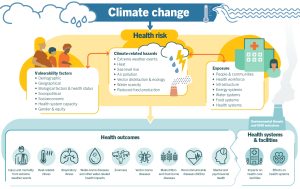Disaster readiness
Disaster readiness involves a continuous four-step process to handle disasters effectively. The first step, mitigation, includes assessing risks and taking actions to prevent or reduce the severity of an emergency. Preparedness follows, where we get ready for emergencies by creating kits, making plans, learning essential skills, and practising them. The third step is the response, where immediate action is taken during a disaster to save lives, prevent the situation from worsening, protect property, and possibly evacuate. Finally, recovery focuses on rebuilding and restoring after the disaster has passed. This process is cyclic, with each disaster offering lessons that help improve safety and readiness for the future.
(Source: Disaster Readiness)
Step 1 – Define the likelihood of disaster in your area and region and understand the disaster impact of your community and the people you are working with
Inform yourself about the risk and likelihood of extreme weather events at the location and region where your organisation, staff and clients are located. Identify the risk likelihood by using the Climate Council’s Climate Risk Map of Australia.
The Australian Council for Social Services has developed a Disaster Resilience Benchmarking Tool so organisations can assess their current state of preparedness for disasters and emergencies to define areas of improvement.
For more details, see the section: Climate Risk Assessment and Disaster Impact
Understanding climate impacts on social injustices and intersectionality
Disaster experts, policymakers, and those working in disaster response need to understand and address why some people face more challenges than others before, during and after disasters. They must work together to create significant and widespread change. Using intersectional approaches helps analyse and challenge unfair practices that affect historically marginalised groups more during disasters. Intersectionality involves understanding how different factors like age, race, sexuality, and gender, as well as conditions like housing, immigration, and marital status, combine to affect people’s experiences and socio-economic outcomes. Studies in disaster research show the benefits of using intersectionality to understand how past discrimination and root causes of vulnerability lead to different risks for different people. It can also help understand how people’s abilities to prepare for, respond to, and recover from disasters vary. However, these intersectional methods are not used enough in disaster studies and sometimes are not applied deeply. To really make a difference, it’s important to move beyond simple views, pay equal attention to different factors, and challenge Western ways of thinking. This will help break down systematic privilege, power, and oppression that cause unequal experiences and outcomes in disasters.
(Source: Intersectionality as a Forward-Thinking Approach in Disaster Research)
Find out more about the climate and disaster risks of the community and people you are working with within our resource: Understanding Climate Impacts on Social In-justices
(Source: World Health Organisation)
Step 2 – Understand the role of community service organisations during and after disaster
See section: The Role of Community Service Organisations during and after a disaster
Step 3 – Understand and adopt community-led disaster preparedness and disaster recovery plans
Provide leadership and build the network to create a framework for action. Follow the guides, steps and tools of the ACOSS, Resilient Community Organisations – Policies and Procedures for Disaster and Emergencies to do so.
See section: Community-led Disaster Preparedness and Just Adaptation
Step 4 – Create a framework for action and disaster ready plan to manage your risk
The Disaster Plan for Community Organisations from the Australian Council for Social Services (ACOSS) includes information on creating a framework for action and examples for policy creation.
This template includes the six stages (steps) to resilience
Stage 1. Leading organisational preparedness for disasters and emergencies
a) Preparedness is a priority: a mandate for action
b) Statement of approach
c) Objectives and Scope
d) Context
e) Disaster Resilience Team
Stage 2. Building networks
a) Local emergency management arrangements
b) Local emergency management plan
c) Emergency service organisations
d) Community service organisations
e) Identifying our at-risk clients
Stage 3. Know your risks
a) The disasters and emergencies our organisation may face
b) Finding your risks
Stage 4. Manage your risks
a) Prevention and adaptation strategies
b) Risk register
c) Business Continuity Plan
d) Insurance
e) Preparing for recovery
f) Disaster and emergency policies and procedures
g) Triggers and key messages identified and communicated
Stage 5. Preparing others
a) Client preparedness
b) Staff and volunteer preparedness
Stage 6. Learn and improve
a) Testing, monitoring and reviewing
b) Learning and sharing
c) Working together to improve disaster resilience in your local community
Disaster Resilience Action Plan Template
The Moreton Bay Regional Council Disaster Resilience Action Plan 2023 provides a planning template that includes goals, disaster key contacts, sign-up to alert systems, and preparation checklists for different disasters (floods, bushfires, draughts, heatwaves).
Step 5 – Review your adaptation plan against climate change with the adaptation justice indicators
The authors of the research paper Connecting Climate Justice and Adaptation Planning: An Adaptation Justice Index (S. Juhola et al. 2022) bring together what has been learned in previous research to make a fairness index for climate adaptation. This index looks at four fairness dimensions: recognition, distribution, procedures, and restoration. It helps analyse and compare different strategies and plans for dealing with climate change in various places and at different levels of government. Since planning for adaptation to climate change is still new, these results can be used to assess how fair adaptation plans are.
| Dimension of Justice | Indicators | Score |
|
1.1. The strategy acknowledges that adaptation needs are different across groups in society | |
| 1.2. The strategy acknowledges the impact of existing societal structures on vulnerable groups in adapting to the impacts of climate change | ||
| 1.3. The strategy acknowledges adaptation as a way to secure basic human rights | ||
| 2. Distributive Justice | 2.1. A risk mapping/assessment is conducted | |
| 2.2. There is a process for identifying vulnerable groups | ||
| 2.3. There is a process that assesses the distribution of benefits from adaptation | ||
| 2.4. There is a process that assesses how the costs of adaptation are divided | ||
| 2.5. The strategy identifies the possibility of the
distribution of negative impacts, i.e., maladaptation, of adaptation measures |
||
| 3. Procedural Justice | 3.1. Adaptation strategy details who participates in the strategy process | |
| 3.2. The adaptation strategy has involved participation during different phases of the process | ||
| 3.3. The strategy allocates responsibilities related to adaptation | ||
| 3.4. The adaptation strategy has a structured plan for participation in the implementation. | ||
| 3.5. The adaptation strategy has a plan for updating and evaluating the strategy | ||
| 4. Restorative Justice | 4.1. The strategy acknowledges the need to compensate for the diverging impacts of climate change | |
| 4.2. The strategy has compensation measures to deal with maladaptation | ||
| 4.3. The unequal distribution of resources for adaptation is compensated by redistribution |
(This table has been developed based on Connecting Climate Justice and Adaptation Planning: An Adaptation Justice Index by S. Juhola et al. 2022)
Step 6 – Prepare others
Being disaster resilient means getting ready to keep people safe and help them recover after a disaster or emergency. Community organisations can help their clients, staff, and volunteers prepare for emergencies. Taking simple actions now can make a big difference for people when they are most at risk during an emergency, especially when the usual support may not be possible.
See: ACOSS – Resilient Community Organisations – Preparing Others
Step 7 – Plan for disaster recovery
See section: Disaster Recovery Planning
Insurance: Insurance Council of Australia
Financial Counselling:
Research/Natural Disaster Financial Discovery Project Western Australia
Natural Disaster and Community Recovery
Relief Payments/Creditor Assistance
- Intake Template for Natural Disasters
- Home Insurance Checklist for Natural Disasters
- General Insurance Checklist for Natural Disasters
Step 8 – Engage in disaster resilience advocacy
See section: Disaster Resilience Advocacy
Step 9 – Evaluate and engage in continuous improvement
Ensure sufficient funding for Lived Experiences Advisory Groups and Aboriginal Advisory Groups and ensure ongoing discussion and consultation structures with community and partners are established. Integrate an evaluation routine for the Disaster Resilience Plan. Include reviewing recent case studies and any changes and learnings from your community, the people you are working with and your organisation.


